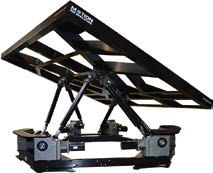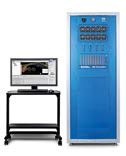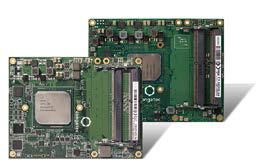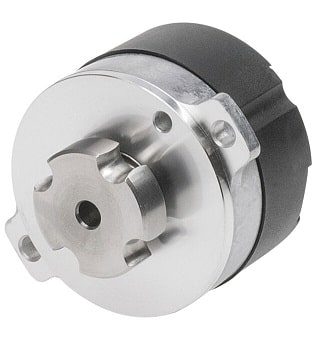Watt Drive drive technology moves highly dynamic carrier platforms for simulation applications.
Belgian company Motion For Simulators (MFS) designs and builds highly dynamic carrier platforms for a wide variety of simulation applications. These include flight simulators, racing games and applications in the area of load behavior. MFS has developed a new movement concept for its multi-axis platforms that allows amateur and professional pilots to fly in flight simulators. The new concept combines dynamic servomotors with efficient bevel-helical geared motors from Watt Drive, a company belonging to the WEG group. Originally, when the company was founded some 20 years ago, MFS was essentially dedicated to the design and construction of aircraft simulators.
Over time, the company wanted to expand its product range by incorporating mobile carrier platforms. Since the search for a suitable “off-the-shelf” provider proved unsuccessful, MFS made the decision to develop its own mobile carrier platforms. Eventually, the original two-axle platform has evolved into a series of standard and custom platforms powered by two, three and six axles. In cooperation with the Belgian company Automotion, after three years of intensive research and development, MFS has succeeded in developing a market-ready system. Simulators on mobile platforms can be used in multiple applications both by professional users –for example, in the medical field or in pilot training– and by amateur users of simulators at home.
New concept of movement
With the aim of improving the performance and efficiency of its simulator platforms, MFS collaborated with Automotive and WEG to develop a new drive concept, which represents a new implementation of the control, which performs all the calculations for the movements, and of the servomotors and geared motors. “Each application is assigned a highly variable load, which is normal on our platforms. It is absolutely necessary that the movement be dynamic and without vibrations. The drive and control technology used has to be robust and must meet the stringent requirements placed on it,” explains Marnix Tahon, company founder and CEO of MFS. Almost all simulation applications are different, and all of them are characterized by very specific requirements in terms of speed, number of axes and acting forces. In order to implement the correct design of the geared motors, the calculation of the mechanical forces, which act from different directions (radial and axial), posed a special challenge. In some cases, WEG has developed special ratios for geared motors with short delivery times.
Comprehensive electromechanical solution
Previously, the axes of simulation platforms were controlled by a separate printed circuit board in combination with a worm drive. However, today the system is powered by a modern PacDrive motion controller along with associated servo motors. To cover the needs of mechanical engineering, as part of the integral solution, it was decided to use Watt Drive helical-bevel reducers, which in some cases had specific transmission ratios for each specific application, suitable for the very special fields of use of the simulators.
In addition, they are equipped with appropriate adapters, with which the motors are coupled to the geared motors. Depending on the application and the number of axes, two, three or six geared motors are used per platform. Drive systems consisting of geared motors and servomotors are integrated into the MFS control software. All movements are controlled through the industrial movement controller and by connecting the new servomotors to helical-bevel reducers. Likewise, it has been possible to increase the limits of axial and radial loads, as well as energy efficiency. Also, compared to hydraulically powered simulators, electrodynamic platforms generate much less noise. Drive systems consisting of geared motors and servomotors are integrated into the MFS control software.
All movements are controlled by the industrial movement controller and by connecting the new servomotors to helical-bevel reducers. Likewise, it has been possible to increase the limits of axial and radial loads, as well as energy efficiency. Also, compared to hydraulically powered simulators, electrodynamic platforms generate considerably less noise. “Using a higher efficiency helical-bevel reducer reduces power consumption and smaller drives can be used to meet the same performance requirements. At the same time, the new geared motors can withstand higher radial and axial forces with the same torque as the previous models, so that the dynamics and load of the platforms can be increased. In summary, thanks to the efficiency of the gear, higher levels of performance are obtained compared to the solution used up to now”, comments Tahon.
higher load capacity
The new movement concept makes possible an extremely fast response of the systems, which translates into cycle times of 1 ms. Apart from higher speeds, advanced moving platforms offer very precise motion control and increased payload capacity. For example, a 10m x 15m platform is currently being worked on, gigantic dimensions for a motion simulator. The new drive concept enables MFS to design systems that would not have been possible in the past, among other reasons, due to the enormous weight to be supported. Systems with a load of 5 to 6 tons are now viable. “We are happy to have our partners. Automotive and WEG not only supply components, but also contribute their experience to develop solutions together with us. They go out of their way to help us, from software support to delivery of materials, including advice on the mechanical integration of their components into our systems. This flexibility is a fundamental requirement for us to be able to develop our application-specific simulators,” concludes Tahon.








